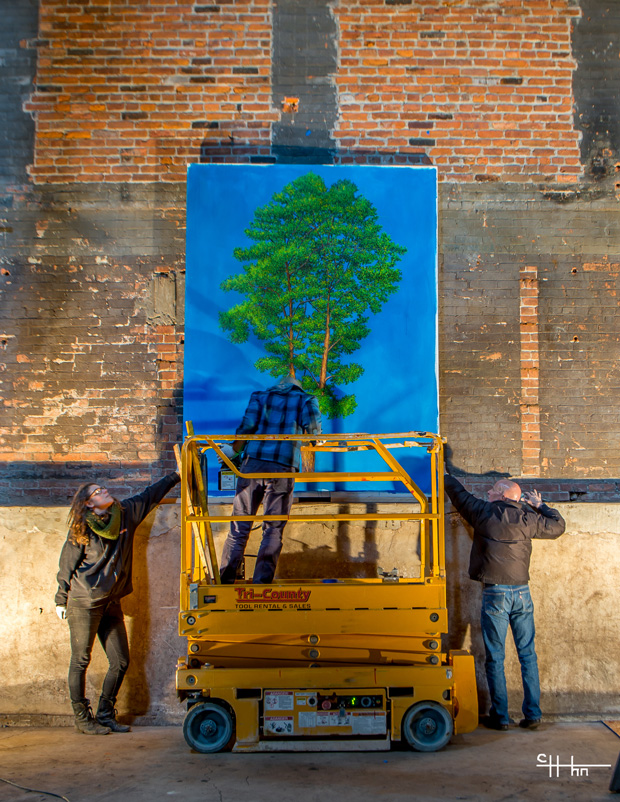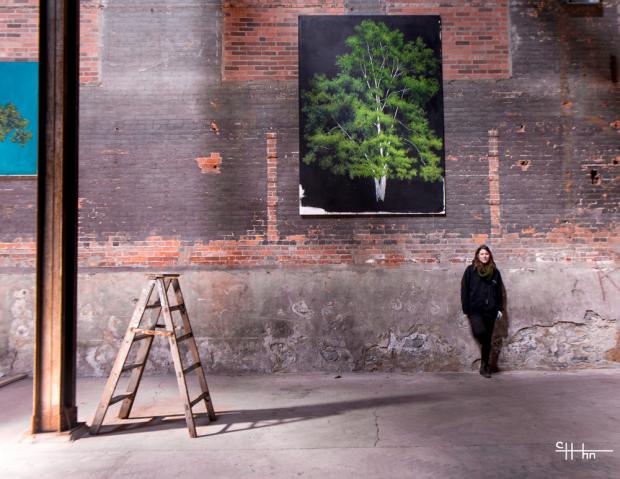Nature and Decay: Sarah Myers and Anna Scime
Different strategies for filling a gargantuan old West Side industrial building reclaimed for the moment as an art exhibit space. In the barn main part of the structure, some huge paintings about huge subject matter—trees—in a representational style that mimics if not replicates the actuality of the subjects. Plus in the barn center space, a few truckloads of sand and half dozen or so multi-ton granite boulders. And in a quasi-cavernous separate back upper room, some epic sensibility films of mushroom spores gravity-applied and indifferently adherent to old—previously photo-processed—16-millimeter film stock. Along with some light box displays of similarly spore-treated film. Still-life examples of what’s playing through dual projectors.
The tree paintings are by Sarah Myers. The spore films are by Anna Scime. The building is the flaking white paint behemoth on Niagara Street a few blocks north of the Peace Bridge, a block or so south of Ferry Street. An old malt processing plant of some sort. For the brewing industry the previous time it was going industry in Buffalo. But long since abandoned, and somewhat deteriorated during the abandonment years.
Myers said she had an informal tour of the building some years ago and determined then and there she would someday, somehow, have a show of her artwork in it. She said she got permission from the present owner, but then she and Scime and 20 or so friends of the artists had to clean out 10 dumpster loads of junk and garbage and whatnot to start to make the place presentable for an exhibit.

(Maybe after all the hard work and artistic notice, the building—like the brewing industry—can have a rebirth. It’s a magnificent structure, brick walls and two great interior rows of vertical iron beams, maybe 40-foot-tall, and kind of raised stage area at one end of the building, something to do with the malting process. And above and behind the stage space, the separate back upper room. A few noticeable gap holes in the brick walls, and apparently also—following a rainstorm—in the roof. But refurbishment not out of the question, you would think.)
Myers’s paintings are hung high on the 40-foot walls. One glorious tree per painting—identified on the labels as to species, but in most cases you won’t need a label for the identification—the oaks are clearly oaks, the elm is incontestably an elm, the maple assuredly a maple, the twin birches manifestly birches—in a painterly vivid impasto technique that suggests the imposing three-dimensionality of the huge trees. And every leaf shown. And every branch, to the extent visible amid thick foliage. Labor of art as labor of love.
The subject matter models are all real trees—palpably—but additionally on warrant of the artist, who can tell you where each subject tree was or is located and the circumstances of the painting of it. A giant oak on the edge of her family farm property in Boston, New York. The elm tree on Richmond, between Summer and Connecticut. A linden on the corner of Connecticut and Plymouth, outside late artist and friend Jack Drummer’s studio. An aspen from Telluride, Colorado, and some gnarly junipers from the Grand Canyon.
Scime, who spends much of her time and energies filming presently re-emerging wonders of the Niagara Frontier waterways—including probably their oldest surviving denizens, notably camera-shy sturgeon fish—is also a serious student and stalker and film documentarian of mushrooms.
The spore print films are created by placing mushroom caps—topside up—on strips of previously processed film, and over the next some hours or days, spores drop onto the film and adhere by whatever infinitesimal forces—gravitational, electrical—to the film. But then, under the more considerable kinetic—not to mention kinematic—forces of loop projection through apparatus—likewise maybe over hours or days—the spores tend to detach from the film, flying off into ambient atmosphere. Entropy in action.
Scime describes the works as about cycles of creation and destruction and archival permanence. Amid impermanence. For even as the spore imagery deteriorates—and audio effects as well, for some spores will have landed on the sound track on the film, resulting in static audio accompaniment to the rapidly changing visual images—the production is digitally recorded and archived.
Maybe more than the movies, the light box displays show the lovely delicate contours and colors of the mushrooms—spore distribution patterns by and large reproduce the gill patterns of the mushrooms they precipitate from, and mushrooms in contact with the film in the making process cause subtle color staining of the film. Beautiful orange-brown Cantharellus cibarius, et al., species in one instance. Ghostly gray gracefully rugose Pleurotus ostreatus in another.
A bonus feature of the reclaimed film work—again maybe more obvious in the light box examples than the movies—occasional spectral remnant images from the previously shot film. Behind the Cantharellus cibarius imagery, the head of a man. Or boy? Or girl?
Access to the exhibit is a little problematic. There was an opening reception, and a closing reception is scheduled for August 20. (And maybe another public event in the meantime, TBA.) For an appointment for a private showing, email Myers at scmyers82@gmail.com, or call her at 716-982-4882.

